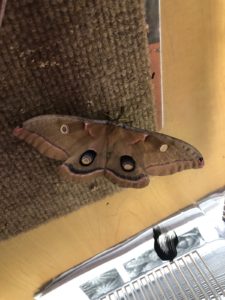One of my favorite parts of being a County Extension Agent is that every day is different! Sometimes I’m out with vegetable farmers talking about weed control. Another day I might be talking about lawncare with homeowners in Sun City or visiting with a classroom of cute kiddos about growing a garden. It’s fun!
On November 13, 2019, we had an interesting visitor at the office. A Williamson County resident brought in a big green caterpillar that she found eating on her tree. She was concerned about the health of her tree since the monster of a caterpillar was eating all the leaves. I was just fascinated by the caterpillar! It was about three inches long, bright green with red tubericles, and about as big around as my thumb.
Our staff quickly adopted the caterpillar and provided her with a terrarium and a branch of leaves. By the next morning, she spun a cocoon in the leaves. We’ve been waiting for months to see what would happen. Today I noticed some new droppings in the terrarium, and sure enough we have a large Polyphemus moth!
The Polyphemus moth is a type of silkworm (Saturniidae) that is common in the United States, southern Canada, and northern Mexico. Adults begin to emerge in the spring to mate and lay oval eggs. Caterpillars develop through several molts before spinning a cocoon among dead leaves that usually fall to the ground. These moths have two generations per year.
Caterpillars have chewing mouthparts, and they feed on the leaves of walnut, hickory, maple, oak, persimmon, willow, and other trees. They shouldn’t be a problem in your trees unless you have an army of these caterpillars come through. That might be a cool sight to see!
Our Polyphemus moth caterpillar (nicknamed Polly) has been a fun visitor, although I have to admit I don’t get quite as excited when I find other kinds of caterpillars like the cabbage looper eating up our veggies in the garden. Those chewing mouthparts can eat up broccoli or lettuce plants in a hurry! Polly is a good reminder that those chewing caterpillars eventually turn into something beautiful. That’s my garden tip and life lesson for the week.
For more information about lawns and gardens, contact Kate Whitney, Horticulture Extension Agent, at 512-943-3300.



